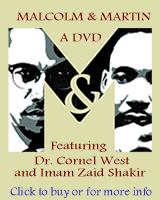
|
|||||||||||||||||||||
|
||||||||||
| Press your F11 Key for a larger full screen view | ||||||||||
 |
||||||||||
|
||||||||||
The current issue is always free to everyone If
you need the access available to a |
||||||||||
 |
||||||||||
During the Spring of 2006, millions of immigrants marched in streets of large cities and small towns alike affirming their basic dignity and demanding a justice which was not tied to citizenship.� Repeated on May 1 2007, these demonstrations herald the surfacing of a massive social movement which will extend participatory democracy in much the same way as the huge organizing waves of the mid 1930s and 1940s and the modern civil rights movement of the late 1950s and 1960s. However, if the movement for immigrant rights signal the next great leap forward in empowerment, what still needs to be answered is how to address the incomplete revolution which took place during the modern civil rights movement.� This race question --- or more accurately, this Black question --- must be answered if social justice movements are to maximize the results from the new opportunities which will arise during the next period.�� This issue is particularly vexing for the labor movement as it tries to build its power.� Immigrant workers have been at the center of many of the most dynamic campaigns for economic justice over the past twenty years.� At the same time, Black workers have been among the strongest supporters of unions since World War II and have shown the greatest propensity and inclination to join unions of any racial/ethnic grouping.� The alienation of just a portion of this support can defeat advances in progressive causes.� Recently, the conservative movement has assiduously cultivated Black public opinion to gain support for its anti-immigrant position.� If they are successful in splitting even a small segment of the Black community from the movement for immigrant rights, the result could be devastating. This note attempts to sketch out an approach to addressing these concerns. Two generations have past since the victories of the modern civil rights movement.� Over this period many working class families and communities have suffered declining fortunes.� This decline in economic outcomes has hit Black communities particularly severe because it occurs in the midst of significant changes.� Some key features of the Jim Crow era were constraints on Blacks in housing and labor markets resulting in �Black� neighborhoods and �Black� jobs.� These constraints formed the basis of a vibrant community with dense social networks, which sustained Blacks during the horrors of segregation and shaped the movement, which eventually overthrew segregation.� With the end of segregation, constraints changed and the last thirty-five years have seen the development of new �Black� spaces.� Some Blacks have migrated outward from the central cities creating new Black neighborhoods and providing the opportunities for the transformation of old Black neighborhoods.� At the same time, the new constraints, in conjunction with the new global economy, have provided new job opportunities and transformed the old Black jobs.� The transformation in Black neighborhoods and Black jobs has resulted in new immigrants penetrating these spaces.
The constellation of these events --- the severe economic crisis in the Black community; the transformation of old Black spaces as a result of the victories of the civil rights movement; and the rise of immigrants from the global South --- have provided the grist for tensions between Blacks and immigrants.� It is my strong belief that these tensions will never be addressed adequately until there is a dynamic movement to tackle the variety of issues reflecting anti-Black racism in the United States. The birth of this movement would be assisted by new framing on three fronts.� First, there has to be recognition that not all Blacks are native-born and not all immigrants are non-Black.� The very positioning of Black �against� immigrants ignores this reality.� That positioning renders invisible disparate immigrant experiences of Blacks from Haiti, Central and South America, the English-speaking and Spanish-speaking islands of the Caribbean, and various countries in Africa.� Such �invisibility� is similar to the treatment of Blacks during Jim Crow and generates feelings of animosity.� Second, what distinguishes social movements is the different social basis of each movement.� The core of the modern civil rights movement was the Black community, which coalesced around issues of racial justice.� In a similar fashion, the core of recent immigrant upsurge has been the Latino community.� Attempts to �frame� the immigrant rights movement as the �new civil rights movement� denies the historical reality of the Black core of the modern civil rights movement and the contemporary reality of the unique features of the Latino immigrant community --- whose experiences and demands for justice are valid on their own merit without the need for the imprimatur of the modern civil rights movement.� By ignoring these realities, some Blacks feel as if �our� movement is being appropriated by others.
Third, the Black community faces a two-dimensional job crisis: a crisis of unemployment and a crisis of low-wage work.� A realistic explanation of the crisis needs to be developed which centers the source of the problem on historical and contemporary institutional racism.� This explanation must emphasize the agency of employers --- as the central players in the determination of who gets hired --- without the response to this employer agency being punitive measures against immigrant workers. However, more
important to the birth of this new movement than issue reframing
are concrete
organizing needs.� Unions need to develop strategies, which
directly deal with the low-wage job crisis in the Black community
by empowering Black workers in the workplace.� This article was originally published in the Fall 2007 issue of the Labor and Working-Class History Association (LAWCHA) Newsletter. BlackCommentator.com Editorial Board member, Steven Pitts, PhD, is a Labor Policy Specialist at the UC Berkeley Center for Labor Research and Education. Click here to contact Dr. Pitts. |
||||||||||
| October
25,
2007 Issue 250 |
|
| Printer Friendly Version in resizeable plain text format format |
 |
 |
 |
| |
| |
































